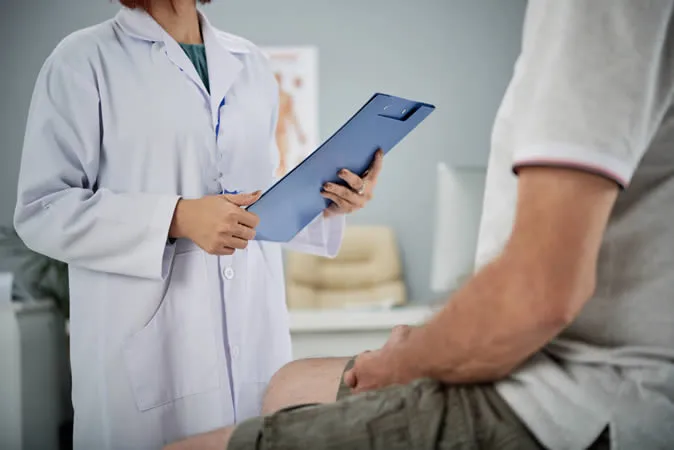Bullous Pemphigoid

What is Bullous Pemphigoid?
Bullous pemphigoid is a rare skin condition that causes large, fluid-filled blisters on the skin due to an autoimmune attack on the basement membrane zone. It is most common in older adults and can be triggered by certain medications, light and radiation therapy, medical conditions, or an unknown cause. It can be diagnosed by skin biopsy, blood tests, and immunofluorescence tests. It can be treated by topical or oral corticosteroids, immunosuppressive drugs, or plasmapheresis. It can last for a few months to several years, and may recur after treatment.

What are the signs and symptoms of Bullous Pemphigoid?
Bullous pemphigoid is a rare skin condition that causes large, fluid-filled blisters on the skin, usually on areas that often flex, such as the lower abdomen, upper thighs or armpits. The blisters can be itchy and painful, and may become infected or lead to scarring. Before the blisters appear, some people may have itching skin, a pink rash, or eczema-like patches. Some people may also have blisters or sores in the mouth or other mucous membranes.
What are the causes of Bullous Pemphigoid?
Bullous pemphigoid is caused by a problem with the immune system, which attacks the skin instead of germs. The immune system produces antibodies that damage the basement membrane zone, a thin layer of tissue below the outer layer of skin. This leads to inflammation and blisters on the skin. The reason for this abnormal immune response is unknown, although it may be triggered by certain medications, light and radiation therapy, medical conditions, or skin damage.
What treatments are available at the dermatologist for Bullous Pemphigoid?

The complications and prognosis of Bullous Pemphigoid
Bullous Pemphigoid can cause serious problems, such as:
- Infection of the skin or the bloodstream, which can be life-threatening if not treated promptly.
- Malnutrition, because painful mouth sores can make it difficult to eat.
- Eye damage, such as scarring, inflammation, or blindness, if the blisters affect the eyes.
- Bleeding disorders, such as low platelet count or hemolytic anemia, due to the immune system attacking the blood cells.
- Increased mortality, especially for older people who have other health problems or a weakened immune system.
The prognosis of bullous pemphigoid depends on the severity and extent of the disease, the response and tolerance to treatment, and the presence of other health problems. The condition may last for a few months to several years, and may recur after treatment. Some people may achieve remission, which means they have no symptoms or need for treatment for a long period of time.
FAQ About Bullous Pemphigoid
How is bullous pemphigoid different from other blistering skin diseases?
Bullous pemphigoid is different from other blistering skin diseases by the location and appearance of the blisters, the type of antibodies involved, and the response to treatment. Bullous pemphigoid affects the subepidermal layer of the skin, while other diseases such as pemphigus vulgaris or pemphigus foliaceus affect the epidermal layer. Bullous pemphigoid produces large, tense blisters that do not rupture easily, while other diseases produce small, fragile blisters that break open easily.
What are the risk factors for developing bullous pemphigoid?
The risk factors for developing bullous pemphigoid include old age, genetic predisposition, neurological diseases, certain medications, light and radiation therapy, and internal malignancy. Old age is the most common risk factor, as most cases occur in people over 60 years old. Genetic predisposition may play a role in some cases, as some people have a variation in the HLA-DQB1 gene that increases their susceptibility to bullous pemphigoid. Neurological diseases such as dementia, Parkinson’s disease, stroke, epilepsy, and multiple sclerosis may trigger or worsen bullous pemphigoid. Certain medications such as etanercept, sulfasalazine, furosemide, and penicillin may induce or exacerbate bullous pemphigoid.
How can I prevent or reduce the recurrence of bullous pemphigoid?
There is no definitive way to prevent or reduce the recurrence of bullous pemphigoid, but some measures may help. These include avoiding or reducing exposure to potential triggers such as certain medications, light and radiation therapy, medical conditions, or skin damage. Applying sunscreen and wearing protective clothing to prevent sunburn and further skin damage. Using gentle skin care products and moisturizers to keep the skin hydrated and prevent irritation.
How does bullous pemphigoid affect the quality of life and mental health of patients and caregivers?
Bullous pemphigoid can affect the quality of life and mental health of patients and caregivers in various ways. The physical symptoms such as itching, pain, infection, scarring, and eye damage can impair daily activities such as eating, sleeping, dressing, working, and socializing. The psychological impact such as anxiety, depression, stress, isolation, stigma, and low self-esteem can affect emotional well-being and interpersonal relationships. The financial burden such as medical costs and loss of income can cause economic hardship and insecurity.
Is there a dermatologist near me in West Palm that offers treatment for bullous pemphigoid?
Yes. At our West Palm dermatology office we offer treatment for bullous pemphigoid to patients from West Palm and the surrounding area. Contact our office today to schedule an appointment.
